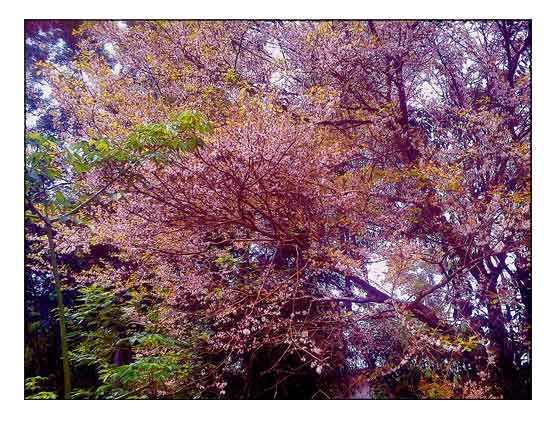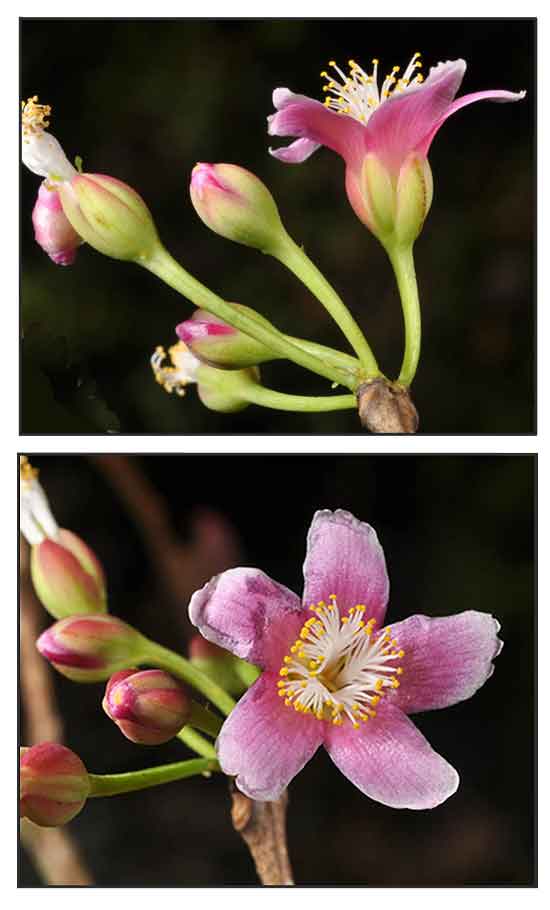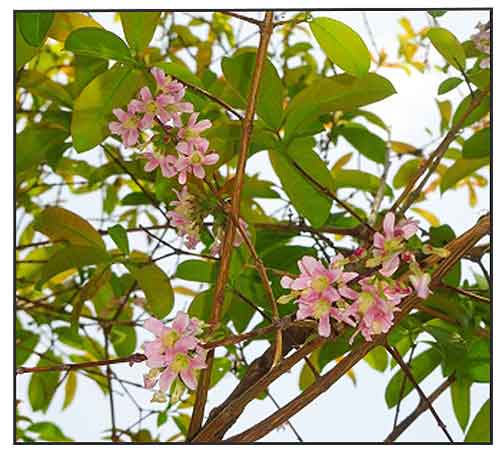 Gen info Gen info
- Cratoxylum (Cratoxylon, an orthographic variant) is a genus of flowering plants in the family Hypericaceae, growing as shrubs or small to medium-sized trees.
- Etymology: The genus name Cratoxylum derives from Greek words, kratos (strength) and xulong (wood), meaning "strong wood", referring to the timber. The specific epithet formosus means beautiful or handsome, referring to the flowers. (20)
Botany
Cratoxylum formosum is a medium-sized to large tree of up to 45 m tall, bole slightly fluted and spiny at base, up to 65 cm in diameter, bark surface papery scaly, grey-brown to red-brown or purplish, inner bark yellow to yellow-brown. Leaves elliptical or lanceolate to ovate or obovate, 3-17 cm × 1-8 cm, with an acute or shortly acuminate to rounded apex, sometimes glaucous beneath. Inflorescence consisting of small 1-6-flowered cymes in the lower axils of shoots or apparently axillary on older branches; flowers heterodistylous, petals white or pink to red or rarely purplish, with an entire nectary scale at base. Seeds (7-)12-17 per locule, unilaterally winged. (1)
 Distribution Distribution
- Native to the Philippines.
- Also native to Andaman Is., Assam, Borneo, Cambodia, China, Hainan, Jawa, Laos, Malaya, Myanmar, Sulawesi, Sumatera, Thailand, Vietnam, (2)
- In primary to old secondary forests and sometimes in savanna, along streams and mangrove swamps, in peat-swamp forest and on hill slopes, on sand or clay soils, up to 600-1200 m altitude. (1)
Constituents
- Study isolated quercetin, quercetin-3-O-β-D-glucopyranoside (isoquercitrin), quercetin-3-O-β-D-galactopyranoside (hyperin), and quercertin-3-O-α-L-rhamnoside (quercitrin). (see study below) (9)
- Betulinic acid was isolated from fraction 52 of chloroform extract of bark. (see study below) (13)
- Study of bark of Cratoxylum formosum subsp. pruniflorum isolated a mixture of new bianthrones J (1a and 1b), along with six known quinonoids, viz. bianthrone A1 (2), vismones E and D (3,4) 11-hydroxy-5-methoxy-2,2,9-trimethyl-2H-anthra[1,2-b]-pyran-7-12-dione (5), vismiaquinone (6), and 3-geranyloxy-6-methyl-1,8-dihydroxyanthraquinone (7). (see study below) (22)
Properties
- Studies have suggested chemopreventive, antigenotoxicity, antioxidant, anti-inflammatory, antihypertensive, anticancer, antimigratory, anti-HIV reverse transcriptase, gastroprotective, cholinesterase inhibitory properties.
Parts used
Leaves, bark, stems.
 Uses Uses
Edibility
- Plant used as ingredient in traditional Thai and Vietnamese cuisines. In China, it is the main ingredient in bitter nail tea.
- Fresh leaves used as Thai vegetable.
- In Laos, edible young leaves can be sour, smooth, or blood-red, depending on subspecies.
Folkloric
- In Thai folk medicine, plant used for treatment of diarrhea, internal bleeding, food poisoning, liver cirrhosis, wound healing, flatulence, and as diuretic, stomachic, and tonic.
- Leaf decoctionn used for colic; resin from bark used for itches. Pounded mixture of bark, leaves, and coconut oil applied to various skin problems. (20)
Others
- Fuel: In Laos, used for production of charcoal.
- Wood: Used for carving, furniture, house construction, poles, and turnery.
Studies
• Antioxidant: In a study of Thai vegetables for antioxidant activity, C. formosum showed 82.60% DPPH inhibition and FRAP 2186.75 µmol FeSO4/100 g sample. Phenolic acid content (mg/g DW) was 1.19 gallic acid, 7.48 chlorogenic acid, 9.98 p-hydroxybenzoic acid. (4)
•
Chemopreventive / Hepatocarcinogenesis: Studies on Cratoxylum formosum ssp. pruniflorum (CP) have confirmed activity against hepatocellular carcinoma. Study investigated the effect of CP on early stage hepatocarcinogenesis in rat liver using diethylnitrosammine (DEN) as carcinogen. CP treatment diminished the formation of cancerous tissues and inhibited hepatocarcinogenic effects in the animal model. (5)
• Antihypertensive: Studies evaluated the effect of Cratpxylum formosum extract on blood pressure, vascular structure and function in hypertensive rats. Rats received L-NAME and treated with CF extract or captopril or captopril + CF. The CF extract attenuated hypertension, enhancement of nerve-mediated contractile responses, endothelial dysfunction and oxidative stress markers and raised concentrations of NOx in L-NAME treated rats. The extract alleviated aortic hypertrophy associated with increases in serum ACE activity, plasma angiotensin II level, and At1R/Akt/STAT3 protein expression in hypertensive rats. Captopril + CF extract showed greater effects on blood pressure reduction and vascular hypertrophy. The antihypertensive effect may be linked to antioxidant effect, enhanced NO bioavailability and an inhibitory effect on RAS cascade. (6)
• Anti-Genotoxicity / Leaves: Studies evaluated a water extract of C. formosum leaves for genotoxicity and anti-genotoxicity effects using micronucleus test and comet assay in TK6 cells. Results revealed absence of genotoxicity of CF leaf extract in TK6 cells. In anti-genotoxicity test, the leaf extract showed moderate inhibition of DNA damage in both invitro comet assay and micronucleus test. The protective effect may be due to the phenolic compound in the leaf and its antioxidant activity. (7)
• Anticancer / Cervical Cancer Cell Lines: Cervical cancer has the human papilloma virus as its main cause. Study evaluated the cytotoxicity of Teawdang extracts (crude hexane, ethyl acetate, methanol, and water extracts) in cervical cancer cell lines. HPLC showed all crude extracts contained caffeine, ferulic acid, and resveratrol. ME and EAE showed high contents of gallic acid and quercetin. Cytotoxicity testing showed the EE had lowest IC50 on HeLa (143.18 µg/ml) and SiHa cells (106.45 µg/mL). C-33A cells were inhibited by the WE (IC50 130.95 µg/mL). Results suggest several phenolic compounds in the extract may have cytotoxic effects on cervical cancer cell lines. (8)
• Anti-Inflammatory / Antioxidative / Quercetin and Glycosides: Study isolated quercetin, quercetin-3-O-β-D-glucopyranoside (isoquercitrin), quercetin-3-O-β-D-galactopyranoside (hyperin), and quercertin-3-O-α-L-rhamnoside (quercitrin). Compounds were evaluated for antioxidative and anti-inflammatory activities. Quercetin displayed weaker antioxidant activity than its glycosides. Celluular antioxidant capacity of quercetin and hyperin was stronger than isoquercitrin and quercitrin. Anti-inflammatory activity of quercetin was higher than glycosides in nitric oxide (NO) production, iNOS expression, and nuclear factor (NF-kB) activation, suggesting quercetin inhibits NO production in LPS-stimulated RAW 264.7 cells via control of iNOS expression with attenuation of NF-kB activation. Results suggest presence of a monosaccharide in quercetin glycosides that may play a critical role in cellular antioxidant and anti-inflammatory activities. (9)
• Cytotoxicity in Oral Cancer Cell Lines: Study evaluated Teawdang powder hexane, ethyl acetate, methanol extracts for cytotoxicity against Asian oral cancer cell lines, ORL-48 and ORL-136. Methanol and ethyl acetate extracts showed higher TPC, TFC, and antioxidant activity than hexane extract. Both ME and EAE at 200 µg DW/mL were cytotoxic to oral cancer cell lines. However, the ME was cytotoxic to Vero cells, while the EA was not, indicating the ethyl acetate extract is a potential candidate as anti-oral cancer agent. (10)
• Silver Nanopartices / Antibacterial, Oral Cancer Cell / Twigs: Study reports on the green and cost-effective synthesis of AgNPs using C. formosum as reducing, capping, and stabilizing agent. The green synthesized AgNPs showed less genotoxicity and less cytotoxicity than chemically synthesized AgNPs. TPOC of the AgNPs was 56.8 µg GAE/mg. Antioxidant activity by DPPH scavenging assay showed IC50 of 76.9 µg/ml and FRAP of 0.29 mmol FeSO4/g sample.
Antibacterial testing showed MICs of 50-100 µg/ml against different strains of S. aureus, 200 µg/ml in E. coli, and ≥ 400 µg/ml in Serratia marcescens. The AgNPs showed anticancer activity against HCT116, MCF7, and SK-MEL-2 cells with IC50s of 51.3, 53.9, and 111.1 µg/ml, respectively. Results suggest multipurpose pharmaceutical applications. (11)
• Gastroprotective / Acid/Alcohol Induced Mucosal Damage / Leaves: Study evaluated the gastroprotective effect of ethanolic extract of C. formosum leaves in gastric ulceration induced by oral administration of acid/alcohol in male Wistar rats. Pretreatment with 500 mg/kg extract prior to acid-alcohol induction completely protected against mucosal damage. Biochemical analysis of gastric mucosa showed significant decrease of malondialdehyde in the extract treated group in a dose-dependent manner. The gastroprotective activity was attributed to antioxidant effect. (12)
• Anti-HIV-1 Reverse Transcriptase Activity / Antioxidant / Bark: Study evaluated five combined fractions (CFA-CFE) from bark extract for antioxidant activity based on TPC, TFC, FRAP, and NO radical scavenging activity and anti-HIV-1 reverse transcriptase activity. CFE showed highest antioxidant activity with TPC, TFC, and FRAP of 44.84 GAE/g, 580.69 µg QE/g, and 82.56 µg Trolox equivalents/g of DW, respectively. The methanolic bark extract, fractions CFC, CFD, and CFE showed high inhibitory effects against HIV-1 with greater than 60% relative inhibition. CFE had highest inhibition comparable to standard drug Nevirapine. (13)
• Alleviation of Testicular Damage in Hypertensive Rats: Study evaluated the effects of C. formosum Dyer ssp. extract on testicular damage in hypertensive male Sprague-Dawley rats induced by L-NAME for 5 weeks and treated with CF extract or sildenafil during the final 2 weeks. The CF extract significantly reduced systolic blood pressure and alleviated impaired sperm quality and seminiferous tubular morphology in hypertensive rats. The CFE restored reduced serum testosterone and protein expression of steroidogenic acute regulatory protein (StAR), nuclear factor erythroid-related factor 2 (Nrf2), and haem oxygenase 1 (HO-1). Decreased testicular and plasma malondialdehyde (MDA) levels and superoxide production were all normalized. Endothelial nitric oxides synthase (eNOS) expression in testicular tissue and plasma nitrate/nitrite levels were also restored. Potential molecular mechanisms may involve suppression of oxidative stress and restoration of StAR, Nrf2, HIO-1 and eNOS expression in the hypertensive rats. (14)
• Inhibition of Growth and Metastasis of Cholangiocarcinoma Cells / Leaves: Study evaluated the anticancer effects of leaf extracts of C. formosum on human cholangiocarcinoma (CCA) KKU-M156 cells. Results showed potent cytotoxicity against CCA cells. Activity was associated with induction of cell apoptosis, along with inhibition of colony forming ability of the CCA cells. The extract induced cell cycle arrest at the G2/M phase and downregulated cyclin A and Cdc25A protein expression, and potently suppressed migration and invasion properties of the CCA cells. Effects were associated with suppression of NF-kB and STAT3 nuclear translocation and transcriptional activity, and downregulation of genes involved in cancer progression and metastasis. Results suggest promising potential for CCA prevention and treatment. (15)
• Zinc Oxide Nanoparticles / Antibacterial / Anticancer / Leaves: Study reports on the green synthesis of zinc oxide nanoparticles (ZnONPs) using crude water extract of leaves. Agar disc diffusion assay demonstrated ZnONPs inhibited growth of Gram-positive B. subtilis and S. epidermis and Gram-negative E. coli. The NPs also exhibited potent anticancer activity against non-melanoma skin cancer cells (A431) and intermediary of cancerous keratinocytes (HaCaT) without affecting normal cell lines (Vero). (16)
• Antibacterial Against Periodontopathic Bacteria / Stem Bark: Study evaluated the antimicrobial effects of C. formosum ssp. pruniflorum stem bark extract and C. lansium against periodontopathic bacteria viz. Porphyromonas gingivalis, Prevotella intermedia, Aggregatibactor actinomycetemcomitans, and Fusobacterium nucleatum, and cytotoxic effect on human gingival fibroblast (HGF) cells in vitro. The extracts showed comparable bacterial efficacy against black-pigmented bacteria strains to standard drug chlorhexidine. The CD50 of C. formosum on HGF cells was 0.37 mg/ml, using MTT assay. (17)
• Antidiabetic / Flowers: Study evaluated the antidiabetic activity of various plant part extracts of C. formosum subsp. formosum. Target enzymes were pancreatic α-amylase (pAA), saccharomyces α-glucosidase (SAG), rat intestinal maltase (rIM), and sucrase (rIS). The DCM (dichloromethane) and EtOAc (ethyl acetate) extracts from flowers exhibited similar inhibitory activities ( IC50s 5.4 and 10.5 µg/ml) as acarbose in the pAA assay. The inhibitory activity of DCM from flowers ( IC50 16.9 µg/ml) was comparable to acarbose (IC50 15.5 µg/ml) on rIS assay. Results showed DCM and EtOAc extracts of flowers were more active than leaves, roots, and stems in the inhibition of defined target enzymes. (18)
• Antibacteria / Roots: Phytochemical study of roots of C. formosum spp. pruniflorum isolated a new xanthone, cratopruniforone (1), along with 13 known compounds (2-14). Compound 4 showed strong antibacterial activity against M. luteus, B. cereus, B. subtilis, and S. aureus with MICs in range of 4-8 µg/ml. Compound 12 exhibited good antibacterial activity against one strain, M. luteus, with MIC of 8 µg/ml. Compounds 4 and 7 showed moderate activity against Staph. epidermis with MIC of 32 µg/ml. (19)
• Anticancer / Activation of TRAIL Death Receptor Complex: Cratoxylum formosum spp pruniflorum (CFP) exhibited selective cytotoxicity against hepatocellular carcinoma HepG2 cells with multi-mode of action. CFP caused DNA damage via alkylation and inhibited DNA supercoiled relaxation. It induced apoptosis via both intrinsic and extrinsic pathways and induced the cross talk. Overexpression of TRAIL5 and increase caspase-8 activity indicated extrinsic apoptosis. Increase Bax-Bcl-2 ratio and caspase-9 activity depicted the effect of CFP via the intrinsic pathway. (21)
• Quinonoids / Antibacterial / Cytotoxic / Bark: Study of bark of Cratoxylum formosum subsp. pruniflorum isolated a mixture of new bianthrones J (1a and 1b), along with six known quinonoids (2-7). Antibacterial and cytotoxic activities of compounds 3 and 4 were reported. (see constituents above) (22)
• Antifungal / Gum: Study evaluated the antifungal activity of Cratoxylum formosum gum against Candida glabrata and its α-mangostin content. The gum showed inhibitory effect against C. glabrata (clinical isolate and ATCC22019) with zones of inhibition ranging from 14.3 to 102 mm, with MIC of 1.25 mg/mL. By HPLC, α-mangostin content of C. formosum gum was 4.08% (w/w). Results suggest potential for a novel antifungal agent. (23)
• Protection Against Amyloid-Beta Toxicity / C. elegans Model of Alzheimer's Disease / Twigs: Amyloid-ß, one of the hallmarks of Alzheimer's disease, is toxic to neurons and causes cell death in the brain. Study evaluated the protective effect of twig extract from C. formosum against amyloid-ß using transgenic Caenorhabditis elegans model. The extract significantly delayed amyloid-ß-induced paralysis in the C. elegans model of Alzheimer's disease. The extract ameliorated oxidative stress by reducing the level of H2O2, which appears to account for the protective action of the extract. Antioxidant activity against juglone-induced oxidative stress increased survival of stressed worms. The extract also decreased expression of heat shock protein-16.2 gene induced by thermal stress, indicating ability to reduce cellular stress. Results suggest the C. formosum extract has potential for the development of anti-Alzheimer's drug. (24)
• Cholinesterase-Inhibiting Potential / Anti-BACE1 Activity / Leaves: Alzheimer's disease is associated with decline in brain functions of memory and cognitive loss Cholinesterases (ChEs) including acetylcholinesterase (AChE) and butyrylcholinesterase (BChE) are key enzymes in the degradation of neurotransmitters. Overproduction of ß-secretase (BACE1) can generate insoluble ß-amyloid peptides. Retardation of enzyme reactions can lead to potential AD prevention. Study evaluated the invitro anti-AD activity through key enzymes from local Thai plants viz. Garcinia cowa, Spondias pinnata, Syzygium granatum, Tamarind indica, and Cratoxylum formosum. All the plants possessed different degrees of anti-ChEs activity. Most hexane extracts exhibited higher anti-AChE activities than ethanol extracts. Only Cratoxylum formosum, G. cowa, and T. indica possessed anti-BACE1 activity. (25)
• Cytotoxic / Antimigratory Effects Against HepG2 Liver Cancer Cells: Study evaluated the molecular mechanisms underlying C. formosum (CF) Dyer-induced cancer cell death and antimigratory effects in HepG2 liver cancer cells using sulforhodamine B, colony formation, and wound healing assays. CF induced HepG2 cells death in a time- and dose-dependent manner. Treatment caused a significant and dose-dependent decrease in colony forming ability and cell migration. CF induced ROS formation, increased caspase 3 activities, and caused HepG2 apoptosis. CF leaf extracts induced cell death, stimulated apoptosis, and inhibited migration in HepG2 cells. Results suggest potential candidate for treatment of liver cancer. (26)
• Enhancement of Oxidative Stability of Rice Crackers: Study evaluated the antioxidative activity of extract of C. formosum in refined soybean oil coating on rice crackers without any seasoning, which were store in accelerated oxidation conditions at 40°C, 80% relative humidity (RH) in the dark for 18 days. The C. formosum extract was more effective than α-tocopherol due to metal ions present in the crackers, which resulted in α-tocopherol being less effective as an antioxidant. Results indicated the C. formosum extract was a promising source of natural food antioxidant and was effective in inhibiting lipid oxidation in rice crackers. (27)
Availability
Wild-crafted.
Ornamental cultivation.
|

![]()




 Distribution
Distribution
